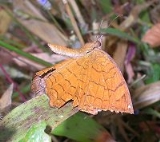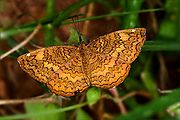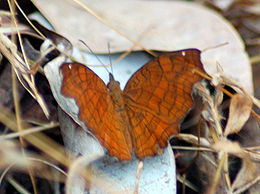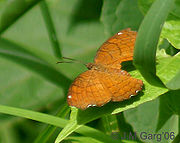
Ariadne ariadne
Encyclopedia
Ariadne ariadne, also known as the Angled Castor, is a species of nymphalid
butterfly found in Asia
.
Males and females have fore wing truncate at apex; termen angulated at interspace 5, and again at apex of vein 3, concave between; tornus obtusely angulate. Hind wing: termen more or less deeply scalloped. Male upperside ochraceous rufous ; a prominent white small subcostal spot before apex of fore wing; two or three dark brown marks in cell of both fore and hind wings, followed by subbasal, discal, two postdiscal, subterminal and terminal slender sinuous dark brown lines, crossing from costa of fore to vein 1 of hind wing; discocellular nervules of both wings defined by short dark brown lines ; cilia white, alternated with brown. Underside : ground-colour similar, but with a tint of brown. Fore and hind wings: some dark chestnut-brown spots or loop-like marks at base, followed by subbasal, discal and postdiscal broad chestnut-brown sinuous bands, interrupted on the fore wing by the sex-mark of specialized scales described below ; the postdiscal band on the hind wing traversed by a series of transverse dark spots in the interspaces. Lastly, both wings crossed by a subterminal zigzag, and a terminal, irregularly sinuous, dark brown line.


 Antennae, head, thorax and abdomen ochraceous rufous. Sex-mark : the subcostal vein and veins 6 and 7 on the upperside of the hind wing prominently pale and shining and a large discal patch of specialized, very dark shining scales on the underside of the fore wing extending to the base of the wing, upwards into the cell and to vein 4. Females similar, slightly paler in colour, of course without the special sex-marks.
Antennae, head, thorax and abdomen ochraceous rufous. Sex-mark : the subcostal vein and veins 6 and 7 on the upperside of the hind wing prominently pale and shining and a large discal patch of specialized, very dark shining scales on the underside of the fore wing extending to the base of the wing, upwards into the cell and to vein 4. Females similar, slightly paler in colour, of course without the special sex-marks.
Ariadne ariadne bears much resemblance to Ariadne merione
, the Common Castor, but in the Angled Castor, the transverse chestnut bands are narrower and less diffuse.
Nymphalidae
The Nymphalidae is a family of about 5,000 species of butterflies which are distributed throughout most of the world. These are usually medium sized to large butterflies. Most species have a reduced pair of forelegs and many hold their colourful wings flat when resting. They are also called...
butterfly found in Asia
Asia
Asia is the world's largest and most populous continent, located primarily in the eastern and northern hemispheres. It covers 8.7% of the Earth's total surface area and with approximately 3.879 billion people, it hosts 60% of the world's current human population...
.
Description
- See glossary of Lepidopteran termsGlossary of Lepidopteran termsThis glossary describes the terms used in the formal descriptions of insect species, jargon used mostly by professionals or entomologist....
for terminology used
Males and females have fore wing truncate at apex; termen angulated at interspace 5, and again at apex of vein 3, concave between; tornus obtusely angulate. Hind wing: termen more or less deeply scalloped. Male upperside ochraceous rufous ; a prominent white small subcostal spot before apex of fore wing; two or three dark brown marks in cell of both fore and hind wings, followed by subbasal, discal, two postdiscal, subterminal and terminal slender sinuous dark brown lines, crossing from costa of fore to vein 1 of hind wing; discocellular nervules of both wings defined by short dark brown lines ; cilia white, alternated with brown. Underside : ground-colour similar, but with a tint of brown. Fore and hind wings: some dark chestnut-brown spots or loop-like marks at base, followed by subbasal, discal and postdiscal broad chestnut-brown sinuous bands, interrupted on the fore wing by the sex-mark of specialized scales described below ; the postdiscal band on the hind wing traversed by a series of transverse dark spots in the interspaces. Lastly, both wings crossed by a subterminal zigzag, and a terminal, irregularly sinuous, dark brown line.



Ariadne ariadne bears much resemblance to Ariadne merione
Ariadne merione
Ariadne merione, also known as the Common Castor, is an orange butterfly with brown lines whose larvae feed almost exclusively on Castor Ricinus communis. It is similar in appearance to Ariadne ariadne, the Angled Castor....
, the Common Castor, but in the Angled Castor, the transverse chestnut bands are narrower and less diffuse.

